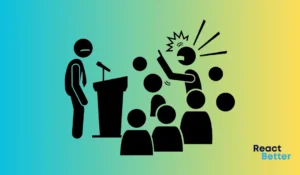Receiving negative feedback from your boss can be a challenging experience. It’s natural to feel defensive or discouraged, but how you respond can make all the difference in your professional growth and relationship with your supervisor.
I’ve been through my fair share of tough conversations with managers, and I’ve learned that the right approach can turn criticism into an opportunity for improvement.
Here are 60+ effective responses to handle boss’s negative feedback. These strategies will help you navigate these tricky situations with grace and professionalism, setting you up for success in your career.
Table of Contents
Constructive Responses to Negative Feedback
1. “Thank you for bringing this to my attention. I appreciate your honesty.”
Expressing gratitude shows maturity and openness to feedback. It sets a positive tone for the conversation and demonstrates your willingness to learn and improve.
2. “I understand your concerns. Could you provide specific examples to help me better grasp the issue?”
Asking for concrete examples allows you to fully comprehend the feedback and address the problem more effectively. It also shows your boss that you’re taking their input seriously.
3. “I see your point. What steps would you recommend I take to improve in this area?”
This response shows initiative and a proactive approach to problem-solving. It invites your boss to collaborate with you on finding solutions.
4. “I wasn’t aware that my performance in this area was lacking. Can we discuss some strategies for improvement?”
Acknowledging your lack of awareness demonstrates honesty and a willingness to learn. It opens the door for a constructive conversation about growth opportunities.
5. “I understand the importance of this issue. Can we set up a follow-up meeting to review my progress?”
Proposing a follow-up meeting shows commitment to addressing the problem and allows you to track your improvement over time.
Related Read: Responding to False Allegations: 12 Strategies to Consider
6. “I appreciate your feedback. Is it alright if I take some time to reflect on this and come back to you with a plan?”
This response gives you time to process the feedback emotionally and develop a thoughtful action plan, rather than reacting defensively in the moment.
7. “I see how this impacts the team. What can I do to better support our collective goals?”
Acknowledging the wider impact of your performance demonstrates your commitment to the team and your understanding of your role within the organization.
8. “I’m committed to improving in this area. Are there any resources or training opportunities you’d recommend?”
This response shows initiative and a desire for professional development. It also gives your boss the chance to provide additional support.
9. “I value your perspective. Can you help me understand how this aligns with our department’s objectives?”
Asking about the bigger picture shows that you’re thinking strategically and want to ensure your work contributes to broader organizational goals.
10. “I hear your concerns. Would it be helpful if I provided regular updates on my progress in this area?”
Offering to keep your boss informed demonstrates accountability and proactiveness in addressing the issue.
Related Read: 59 Update Responses: Ease the Pressure of Progress Reports
Responses for Seeking Clarification
11. “Could you elaborate on what you mean by [specific point]? I want to make sure I fully understand.”
Seeking clarification ensures that you and your boss are on the same page regarding the feedback. It prevents misunderstandings and shows your commitment to addressing the issue accurately.
12. “I’m curious about the metrics you’re using to evaluate this aspect of my performance. Could you explain them in more detail?”
Understanding the evaluation criteria helps you align your efforts with your boss’s expectations and provides a clear target for improvement.
13. “Can you share an example of how you’d like to see me handle a similar situation in the future?”
Asking for a concrete example of desired behavior gives you a clear model to follow and demonstrates your willingness to adapt your approach.
14. “I’d like to understand the priority of this issue compared to my other responsibilities. How should I balance addressing this with my current workload?”
This question shows that you’re thinking about how to integrate the feedback into your overall job performance and helps you manage your time and resources effectively.
15. “Are there any specific skills or competencies you think I should focus on developing to address this feedback?”
This response demonstrates your commitment to professional growth and helps you identify targeted areas for improvement.
16. “Can you help me understand how this feedback relates to my long-term career goals within the company?”
Connecting the feedback to your career trajectory shows that you’re thinking about your future with the organization and are committed to aligning your performance with company needs.
17. “I’d like to get a better sense of the timeline for improvement. What are your expectations for when you’d like to see changes?”
Understanding the timeframe helps you set realistic goals and demonstrates your commitment to meeting your boss’s expectations.
18. “Could you share any best practices or success stories from other team members who have excelled in this area?”
This question shows initiative in seeking out models of success and a willingness to learn from your colleagues.
19. “I’m interested in understanding how this feedback relates to recent changes in our team/department/company. Can you provide some context?”
This response demonstrates your awareness of the broader organizational context and your desire to align your performance with evolving needs.
20. “Can we discuss any potential barriers or challenges you foresee in my efforts to improve in this area?”
Asking about potential obstacles shows that you’re thinking critically about the improvement process and are prepared to address challenges proactively.
Responses for Taking Ownership

21. “You’re right, I can see where I fell short. I take full responsibility for this mistake.”
Taking ownership of your errors demonstrates maturity and integrity. It shows your boss that you’re not making excuses and are ready to learn from the experience.
22. “I understand the impact of my actions. I’m committed to making this right and preventing it from happening again.”
This response acknowledges the consequences of your mistake and shows a proactive approach to rectifying the situation and improving for the future.
23. “I realize now that I should have approached this differently. I’ll use this as a learning opportunity to improve my decision-making.”
Reflecting on your choices and committing to learn from them demonstrates growth mindset and adaptability.
24. “I see that I misjudged the situation. I’ll be more careful to consider all angles in the future.”
This response shows self-awareness and a commitment to improving your analytical skills and judgment.
25. “I understand that my performance in this area has been inconsistent. I’m going to focus on developing better habits to ensure consistency.”
Acknowledging inconsistency and committing to develop better habits shows that you’re taking a systematic approach to improvement.
26. “I recognize that I’ve been struggling with [specific issue]. I’m going to seek out additional training/support to address this.”
This response demonstrates self-awareness and initiative in addressing your weaknesses.
27. “I see now that I didn’t communicate effectively about this issue. I’ll work on being more transparent and proactive in my communication.”
Acknowledging communication failures and committing to improve shows that you understand the importance of clear, open dialogue in the workplace.
28. “I realize I’ve been resistant to change in this area. I’m going to work on being more adaptable and open to new approaches.”
This response shows self-reflection and a willingness to embrace change, which is valuable in today’s dynamic work environments.
29. “I understand that my actions affected the team negatively. I’ll make a concerted effort to be a more supportive team player.”
Acknowledging the impact on your colleagues demonstrates empathy and commitment to the team’s success.
30. “I see that I’ve been focusing too much on [less important aspect] at the expense of [more critical area]. I’ll readjust my priorities moving forward.”
This response shows that you’re willing to reassess and realign your efforts based on feedback, demonstrating flexibility and strategic thinking.
Responses for Moving Forward
31. “I’d like to propose a plan to address this issue. Can we discuss my ideas and get your input?”
Taking the initiative to create an improvement plan shows proactivity and demonstrates your commitment to addressing the feedback constructively.
32. “I’m going to set some specific goals based on this feedback. Would you be willing to review them with me to ensure they’re aligned with your expectations?”
This response shows that you’re taking concrete steps to improve and values your boss’s guidance in the process.
33. “I’m going to start tracking my progress in this area. Would it be helpful if I provided you with regular updates?”
Offering to monitor and report on your progress demonstrates accountability and keeps the lines of communication open with your boss.
34. “I’d like to schedule some time to shadow a colleague who excels in this area. Do you have any recommendations?”
This approach shows initiative in seeking out learning opportunities and leveraging the strengths of your team.
35. “I’m going to research some best practices in this area. Would you be open to discussing my findings and how we might implement them?”
This response demonstrates a proactive approach to problem-solving and shows that you’re willing to bring new ideas to the table.
36. “I’m committed to turning this around. Can we set up regular check-ins to review my progress and adjust our approach if needed?”
Proposing regular check-ins shows your dedication to improvement and your desire for ongoing feedback and guidance.
37. “I’d like to use this as an opportunity to develop my skills. Are there any challenging projects in this area that I could take on to accelerate my learning?”
This response shows enthusiasm for growth and a willingness to take on challenges to improve your performance.
38. “I’m going to create a personal development plan focused on this area. Would you be willing to review it and provide your thoughts?”
Creating a formal development plan demonstrates your serious commitment to improvement and values your boss’s input in your professional growth.
39. “I’d like to understand how I can better support our team’s goals while addressing this feedback. Can we discuss how to align my improvement efforts with our broader objectives?”
This response shows that you’re thinking about your personal growth in the context of the team’s success, demonstrating your commitment to the organization.
40. “I’m going to reach out to our HR department about any relevant training opportunities. Would you support me in pursuing additional professional development in this area?”
This approach shows initiative in seeking out formal learning opportunities and ensures your boss is on board with your professional development plans.
Responses for Difficult Situations

51. “I appreciate your feedback, but I see things differently. Could we discuss this further to understand each other’s perspectives?”
This response allows you to respectfully disagree while keeping the door open for further discussion. It shows that you value your boss’s input but also have confidence in your own viewpoint.
52. “I understand your concerns, but I feel that some contextual factors may not have been considered. May I provide some additional information?”
This approach allows you to introduce relevant context that might affect the interpretation of your performance, without directly challenging your boss’s assessment.
53. “I hear your feedback, and while I may not agree with all points, I respect your perspective. How can we work together to find a solution that addresses your concerns?”
This response acknowledges the feedback while expressing a desire to collaborate on finding a mutually satisfactory solution.
54. “I’m surprised by this feedback as it differs from what I’ve heard previously. Can we discuss how expectations may have changed?”
This response is useful when feedback seems inconsistent with previous evaluations. It opens a dialogue about changing expectations or miscommunications.
55. “I understand you’re not satisfied with my performance in this area. Can you help me understand what success looks like from your perspective?”
This question helps clarify expectations and can be particularly useful when you feel the standards are unclear or have shifted.
56. “I hear your concerns, but I’m worried that the proposed solution might have unintended consequences. Can we explore some alternative approaches?”
This response shows that you’re thinking critically about proposed solutions and are willing to engage in problem-solving to find the best approach.
57. “I appreciate your feedback, but I’m concerned that addressing this issue might impact other priorities we’ve discussed. Can we talk about how to balance these competing demands?”
This response demonstrates your awareness of competing priorities and invites a discussion about resource allocation and prioritization.
58. “I understand you’re frustrated, but I feel that some of the language used was quite harsh. Could we have a calm discussion about how to address these issues constructively?”
This response can be used if the feedback was delivered in an overly critical or emotional manner. It advocates for a more professional and productive dialogue.
59. “I hear your feedback, but I’m concerned that it may be based on incomplete information. Would you be open to reviewing some additional data I’ve gathered?”
This approach allows you to introduce new information that might affect the assessment of your performance, without directly challenging your boss’s authority.
60. “I appreciate your input, but I feel that this feedback doesn’t align with my job description or agreed-upon responsibilities. Can we discuss how my role may be evolving?”
This response is appropriate when feedback seems to be based on expectations outside your current role. It opens a dialogue about job responsibilities and potential role changes.
Responses for Positive Action
61. “I’m going to create an action plan based on this feedback. Would you be willing to review it with me next week?”
This response demonstrates initiative and a commitment to improvement. It also involves your boss in the process, showing that you value their input.
62. “I’d like to schedule a follow-up meeting in a month to review my progress. Does that work for you?”
Proposing a follow-up meeting shows that you’re serious about addressing the feedback and are committed to long-term improvement.
63. “I’m going to start keeping a daily log of my efforts in this area. Would you like me to share weekly summaries with you?”
This approach shows that you’re taking concrete steps to monitor and improve your performance, and offers transparency to your boss.
64. “I’m going to reach out to [colleague] who excels in this area for some mentoring. Do you think that would be helpful?”
Seeking mentorship shows initiative and a willingness to learn from others. It also demonstrates that you’re taking a proactive approach to improvement.
65. “I’m going to dedicate time each week to focus specifically on improving in this area. How does that sound to you?”
This response shows that you’re willing to invest time and effort into addressing the feedback, and seeks your boss’s approval for this approach.
66. “I’d like to propose a small project that would allow me to demonstrate improvement in this area. Would you be open to discussing this idea?”
This approach shows creativity in addressing the feedback and a willingness to take on additional responsibilities to prove your growth.
67. “I’m going to set up some time with our training department to explore relevant courses. Do you have any specific recommendations?”
This response demonstrates initiative in seeking out formal learning opportunities and involves your boss in your professional development planning.
68. “I’m going to start benchmarking my performance in this area against industry standards. Would you find that kind of data helpful in our future discussions?”
This approach shows that you’re taking a data-driven approach to improvement and are thinking about your performance in a broader context.
69. “I’d like to propose a new process that could help address this issue. Could we schedule some time to discuss my ideas?”
This response demonstrates proactivity and creative problem-solving. It shows that you’re not just reacting to feedback, but using it as a springboard for innovation.
70. “I’m going to start a peer feedback group to get more regular input on my performance in this area. What do you think about this approach?”
This response shows initiative in seeking diverse perspectives and demonstrates your commitment to continuous improvement.
Responses for Emotional Management
71. “I appreciate your honesty. I’ll need some time to process this feedback, but I’m committed to addressing it.”
This response acknowledges that feedback can be emotionally challenging while affirming your commitment to improvement. It also buys you time to manage your emotions and respond more thoughtfully.
72. “I understand the seriousness of this feedback. While it’s difficult to hear, I’m grateful for the opportunity to improve.”
This response demonstrates emotional maturity by acknowledging the difficulty of the situation while maintaining a positive, growth-oriented mindset.
73. “This feedback has given me a lot to think about. I may need some time to reflect, but I assure you I’m taking it seriously.”
This approach allows you to step back and process your emotions without reacting impulsively, while reassuring your boss that you’re not dismissing their input.
74. “I want to respond to this feedback thoughtfully. Would it be alright if we scheduled a follow-up meeting once I’ve had time to consider it fully?”
This response shows that you’re committed to addressing the feedback but need time to manage your emotions and formulate a constructive response.
75. “I’m feeling a bit overwhelmed by this feedback. Could we break it down into smaller, more manageable areas to address?”
This approach demonstrates self-awareness about your emotional state and proposes a practical way to make the feedback feel less daunting.
76. “I’m committed to improving, but I’m finding this feedback quite challenging. Could you help me prioritize which areas to focus on first?”
This response acknowledges the emotional impact of the feedback while seeking guidance on how to approach improvement in a manageable way.
77. “I appreciate your directness. While this is tough to hear, I’m going to use these emotions as motivation to improve.”
This response demonstrates emotional resilience and the ability to channel difficult feelings into positive action.
78. “This feedback has caught me off guard. I’m going to take some time to reflect on it and come back with a thoughtful response. Is that okay?”
This approach is useful when you’re surprised by the feedback and need time to process it emotionally before responding constructively.
Final Words
Handling negative feedback from your boss is a crucial skill for professional growth. By maintaining composure, actively listening, and viewing criticism as an opportunity for improvement, you can turn challenging conversations into stepping stones for success.
Remember to clarify expectations, develop an action plan, and follow up on your progress. With practice and a positive mindset, you’ll not only navigate feedback sessions more effectively but also strengthen your relationship with your boss and advance your career.
- 25 Top Valentine’s Day Quotes for Friends 2025 - February 12, 2025
- 91 Replies to Respond to Congratulations – For Every Occasion! - February 6, 2025
- 100 Funny Responses To Late Replies In Texting - February 3, 2025





